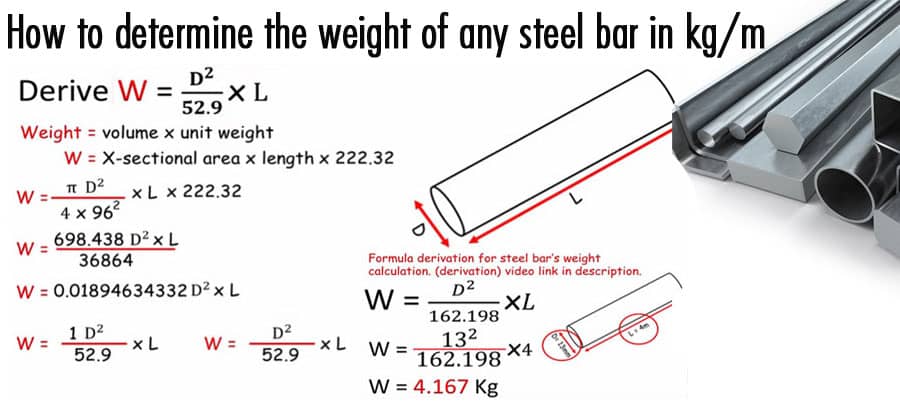How to determine the weight of any steel bar in kg/m?

If you work in construction or engineering, you might need to calculate the weight of steel bars frequently. Steel bars are widely used in construction, manufacturing, and other industries due to their strength and durability.
Introduction
Steel bars are commonly used in construction projects to provide support to structures. They are available in various sizes, shapes, and grades, and their weight can vary significantly based on these factors. It is essential to determine the weight of steel bars accurately to ensure safety and efficiency in construction and manufacturing projects.
Understanding Steel Bars
Steel bars, also known as reinforcing steel or rebar, are long, solid steel rods that are used in construction to add strength to concrete structures. They are typically made of carbon steel and have a ridged surface that provides better adhesion with concrete. Steel bars come in different sizes and shapes, including round bars, square bars, and deformed bars.
Standard Sizes of Steel Bars
Steel bars are available in standard sizes that vary depending on the type of bar and the application. The most common sizes of steel bars are:
- Round bars: 6 mm to 50 mm in diameter
- Square bars: 10 mm to 50 mm in diameter
- Deformed bars: 6 mm to 50 mm in diameter
Density of Steel Bars
The density of steel bars depends on their size, shape, and grade. The density of mild steel is approximately 7.85 g/cm3. You can use this value to calculate the weight of a steel bar.
Formula to Calculate the Weight of a Steel Bar
The weight of a steel bar can be calculated using the following formula:
Weight (kg/m) = (d^2/162) x L
Where:
- d is the diameter of the steel bar in mm
- L is the length of the steel bar in meters
The factor 162 is derived from the density of mild steel (7.85 g/cm3) and the conversion of cm3 to mm3.
Example Calculation
Suppose you have a steel bar with a diameter of 10 mm and a length of 1 meter. Using the formula, you can calculate its weight as follows:
Weight (kg/m) = (10^2/162) x 1
Weight (kg/m) = 0.617 kg/m
Factors Affecting the Weight of Steel Bars
Several factors can affect the weight of steel bars, including:
- Diameter: The weight of a steel bar increases as its diameter increases.
- Length: The weight of a steel bar increases as its length increases.
- Shape: The weight of a steel bar can vary based on its shape, such as round, square, or deformed.
- Grade: The weight of a steel bar can vary based on its grade, such as mild steel or high-strength steel.
Tips for Accurate Calculations
To ensure accurate calculations of the weight of steel bars, follow these tips:
- Measure the diameter and length of the steel bar accurately.
- Use the correct formula for the type of steel bar you are working with.
- Check your calculations using a calculator or spreadsheet.
- Round off the weight to the nearest decimal place for simplicity.
Conclusion
Calculating the weight of a steel bar is essential for construction and manufacturing projects. With the formula and tips provided in this article, you can accurately determine the weight of any steel bar in kg/m. It is important to ensure that your calculations are accurate to ensure safety and efficiency in your projects.
FAQs
What is the density of steel bars?
The density of mild steel, which is commonly used for steel bars, is approximately 7.85 g/cm3.
What is the formula to calculate the weight of a steel bar?
The formula to calculate the weight of a steel bar is: Weight (kg/m) = (d^2/162) x L, where d is the diameter of the steel bar in mm, and L is the length of the steel bar in meters.
How do I measure the diameter and length of a steel bar accurately?
To measure the diameter of a steel bar accurately, use a micrometer or caliper. To measure the length, use a measuring tape or ruler.
Can the weight of a steel bar vary based on its shape?
Yes, the weight of a steel bar can vary based on its shape, such as round, square, or deformed.
Why is it important to calculate the weight of a steel bar accurately?
It is important to calculate the weight of a steel bar accurately to ensure safety and efficiency in construction and manufacturing projects. Incorrect weight calculations can lead to structural failure or other safety hazards.
